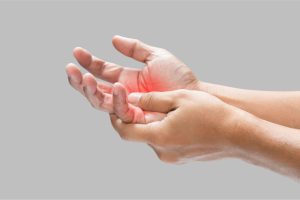You may notice stiffness in your fingers in the morning or a persistent ache in your knuckles by the afternoon. These small changes can be easy to dismiss. However, they may point to early arthritis in hands symptoms. Understanding what to look for allows you to manage the condition more effectively and seek timely support.
Arthritis, particularly osteoarthritis and rheumatoid arthritis, commonly affects the hands. Early detection can make a considerable difference in reducing joint damage and maintaining your hand function.
What Is Arthritis in the Hands?
Arthritis in the hands involves inflammation in the joints of the fingers, thumbs, wrists, or knuckles. The two most common types are:
- Osteoarthritis (OA): Usually develops with age and results from wear and tear of the cartilage.
- Rheumatoid arthritis (RA): An autoimmune condition where the body’s immune system mistakenly attacks joint tissues.
Although these types differ in cause, many of their symptoms of arthritis in hands overlap.

Related Article: How Rheumatoid Arthritis Affects the Hands and What You Can Do About It
Early Signs and Symptoms of Arthritis in Hands
1. Stiffness, Especially in the Morning
One of the earliest arthritis in hands early symptoms is stiffness. You may wake up feeling that your fingers or wrists don’t move as freely. This stiffness often eases as the day progresses but can return after long periods of inactivity.
2. Pain During or After Movement
You might feel aching or a sharp pain when gripping, twisting, or lifting objects. In osteoarthritis, pain typically comes after activity. In rheumatoid arthritis, the pain may be more persistent and symmetrical—affecting both hands at once.
3. Swelling and Tenderness
Mild swelling around the joints can be a tell-tale sign. This might make rings feel tighter or cause tenderness to touch. Swollen joints are one of the more visible arthritis hands symptoms, especially in rheumatoid arthritis.
Related Article: How to Relieve Arthritis Pain in Hands Naturally and Effectively
4. Reduced Range of Motion
You could notice that tasks like buttoning a shirt or opening a jar feel harder. Limited flexibility or a sense of joint locking are key arthritis symptoms in hands and often cause difficulty in daily routines.
5. Warmth or Redness Over Joints
Inflammation may cause the skin over your joints to feel warm or look red. This is particularly noticeable in active rheumatoid arthritis.
6. Bony Growths or Knobbly Knuckles
In osteoarthritis, bone spurs may form around the finger joints, especially the knuckles. These growths can create visible lumps or make joints appear misshapen—a late but classic sign and symptoms of arthritis in hands.
7. Weak Grip or Loss of Strength
Many people with arthritis on hands symptoms report difficulty gripping objects firmly. Tasks like turning a key or holding a pen might become frustrating or painful.
Related Article: Best Joint Supplements of 2025, West Virginia – Herbal Care Products
8. Fatigue and General Discomfort
In autoimmune arthritis, general fatigue often accompanies hand symptoms. You may feel unusually tired even after rest, or notice low-grade fever and general unwellness.
Where You May First Notice Symptoms
The symptoms often start subtly. You may first notice:
- Base of the thumb (carpometacarpal joint)
- Middle finger joints (proximal interphalangeal joints)
- End finger joints (distal interphalangeal joints)
- Knuckles and wrists
Identifying the pattern and location can help differentiate between osteoarthritis and rheumatoid arthritis.
Related Article: Arthritis Sufferers Swear by These 7 Supplements—Find Out Why
What Makes Hand Arthritis Worse?
While the exact cause of arthritis can vary, several factors may worsen arthritis symptoms in hands:
- Cold weather or damp conditions
- Repetitive motions (typing, knitting)
- Previous joint injury
- Poor posture or wrist support
- Stress (in autoimmune forms)
Being aware of these triggers may help you better manage discomfort.
Related Article: Arthritis Relief Supplement: Soothe Aching Joints Naturally
When to Seek Medical Help
You should consult a GP or rheumatologist if:
- Pain persists beyond a few weeks
- Swelling or redness doesn’t go away
- You experience stiffness daily
- Your grip strength weakens suddenly
- There’s visible joint deformity
Early diagnosis and treatment can prevent irreversible joint damage, particularly in autoimmune forms.
How Is Arthritis in the Hands Diagnosed?
To confirm arthritis in the hands, your healthcare provider may:
- Conduct a physical examination
- Order X-rays or ultrasounds to check for joint changes
- Request blood tests (e.g. rheumatoid factor or anti-CCP for RA)
These help confirm the type of arthritis and guide your treatment plan.
Related Article: Cure Your Arthritis Naturally: 10 Proven Remedies That Work
Living with Hand Arthritis: Daily Adjustments That Help
Managing arthritis hands symptoms doesn’t mean stopping your routine—it’s about adjusting it. Consider:
- Wearing compression gloves: These improve circulation and reduce morning stiffness.
- Using assistive tools: Jar openers, pen grips, or voice-to-text apps reduce joint strain.
- Applying heat or cold: Warm compresses soothe stiffness; cold packs reduce inflammation.
- Hand exercises: Gentle stretching can maintain flexibility and ease discomfort.
- Joint protection techniques: Use larger joints for tasks where possible, and avoid tight grips.
Related Article: Joint Support: Natural Joint Supplement for Arthritis Joint Relief Review
Treatments That Support Hand Function
Depending on the type and severity, your treatment may include:
1. Medications
- Pain relievers (Paracetamol, NSAIDs)
- Topical creams (ibuprofen gel or capsaicin)
- Disease-modifying drugs (DMARDs) for RA
- Steroid injections for targeted relief
- Natural Joint Supplement for Arthritis Joint Relief
2. Physiotherapy
A hand therapist or occupational therapist can offer tailored exercises and splints to improve function and reduce pain.
3. Surgery (For Advanced Cases)
If conservative treatment doesn’t help, procedures like joint fusion or joint replacement may be discussed.
Preventing Further Joint Damage
While arthritis cannot always be prevented, these strategies may delay progression:
- Maintain a healthy weight to reduce pressure on joints
- Manage blood sugar levels, especially if you have type 2 diabetes
- Eat a balanced, anti-inflammatory diet
- Avoid repetitive stress without breaks
- Stop smoking, which worsens rheumatoid arthritis symptoms
Final Thoughts
Recognising the sign and symptoms of arthritis in hands can help you take action before the condition becomes limiting. Whether you’re noticing slight stiffness or more obvious changes like joint swelling and reduced grip, your body is signalling that it needs attention. Early diagnosis and lifestyle adjustments often make a significant difference in long-term hand health.




